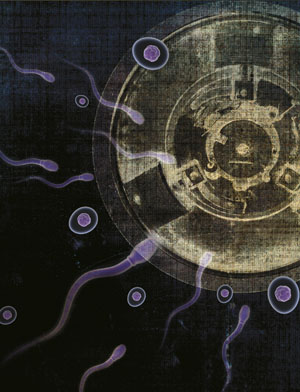
Bank Your Fertility
More couples than ever before are postponing pregnancy by preserving their sperms or eggs
Heard of Nothobranchius? Better known as annual fish, you’d find them in Africa and South America. Only, that is, if you looked for them in the rainy season; they spend their lives in rain-fed ponds and marshes. When the water dries up, they die. But before that, they breed, and bury their eggs under the soil, where they stay until the next rains, when, miraculously, they hatch. The younglings seem to know that the wetlands will dry out, and their lives are short. So, they quickly get down to business, and, like countless generations before them, bury their eggs. Then, of course, the rains end, the water dries up, and they die. But nature’s egg bank makes sure the species survives. Smart lady, Mother Nature.
Given this, is it possible for women to have children safely and successfully later in life? Yes, science caught up with the Nothobranchius a while ago, and there are now several options available.
 Illustrations: Vidyanand Kamat
Illustrations: Vidyanand Kamat For men, sperm banking is fairly easy: Masturbate, collect sperm in receptacle, hand over to the lab assistant. Sperm banking, as a result, is quite common, especially in families where the time the husband and wife spend together is too short to guarantee conception. The husband’s sperm is stored, and artificial insemination takes place when it’s convenient for the wife. The practice is spreading. Dr. Pradeep M. Rao, specialist in foetal medicine at the Centre for Reproductive Medicine and Pre-Natal Diagnosis, Bangalore, says he sees a lot of young techies depositing their sperm, so that they can use it later. “They are busy catching up with their lives, going up the corporate ladder, so they postpone raising a family. And before they know, they are 30, 31, fertility is down, interest levels are lower and chemistry between husband and wife is not quite the same. So, they say, when everything is going well, let’s store it. It’s almost like putting money in your FD and encashing it whenever you want.”
Fear of age-related sterility also drives demand. Dr. Mirudhubashini Govindarajan, who has been in this field since the mid-nineties and practises in Coimbatore, says that some years back, causes were neatly symmetrical: Male infertility, one-third; female infertility, one-third; other reasons, one-third. Now, she says, thanks to a combination of stress-prone lifestyles and external factors such as pollution, the male contribution to the equation has gone up to half.
Sperm banks are one part of Assisted Reproductive Technology (ART), which covers various methods to achieve pregnancy artificially. Like in vitro fertilisation (IVF), where fertilisation happens outside the female body. (“In vitro” is the Latin for “within the glass,” referring to the test tubes and culture dishes in a laboratory.) Dr. Aniruddha Malpani, who runs Malpani Infertility Clinic in Mumbai, says that advances in ICSI (Intra Cytoplasmic Sperm Injection, which improves the chances of fertilising an egg even with a low sperm count) technology, has pushed down demand for semen freezing in his own clinic. For women, for whom it’s more important given ovarian depletion, things are more difficult and complicated, not to speak of, expensive (it costs about Rs. 1.5 lakh to extract and freeze eggs). It requires ovarian stimulation for eggs to develop and often involves an invasive procedure. Chances of eggs damage are high, and the success rate for fertilising preserved eggs is lower than for fresh eggs.
Dr. Malpani says he meets at least one patient every month who wants to freeze her eggs. But, put off by the complexity and cost, few take it forward. “There was this lady who got married quite early in her life. The marriage did not work out, and she got divorced. She is now 34 and runs her own business. She wants to get married, have children and raise a family. But given her bad experience in the past, she does not want to hurry things up. So, her next marriage could take place tomorrow or may be three or five years later. She wanted to preserve her eggs till such time.”
Dr. Priya Selvaraj, of GG Hospital in Chennai, says she actively discourages women who see egg freezing as a way to get pregnant later. “I tell them, you have to get your priorities right.”
Other practitioners share her view, but where the desire is medically driven, it is encouraged. Like with cancer patients; women who undergo chemotherapy risk becoming sterile. Ahead of treatment, they extract and freeze their eggs. Later, when they get healthy enough to bear a child, they have the option to use their own eggs.
 freezing is a part of the IVF procedure. Patients may opt to have multiple eggs fertilised during IVF, but only one or two implanted in the uterus. The others aren’t discarded, but kept in the freezer. There’s a reason. Says Dr. Mirudhubashini: “Often, parents come back to us two or three years later for their second child. They don’t have to go through the whole process again. We use the
freezing is a part of the IVF procedure. Patients may opt to have multiple eggs fertilised during IVF, but only one or two implanted in the uterus. The others aren’t discarded, but kept in the freezer. There’s a reason. Says Dr. Mirudhubashini: “Often, parents come back to us two or three years later for their second child. They don’t have to go through the whole process again. We use the frozen embryo.”
It’s somewhere here that the question of ethics comes up. Pro-lifers, who believe that life starts at conception, look at this in the same way that they look at abortions. In their view, fertilising multiple eggs is like producing a dozen human beings when you want only one. And when you discard or freeze the rest, it is like killing or freezing a real person. Some Catholic countries have strict laws against IVF. But views even among traditionalists differ. In Judaism, for example, a baby is considered to come to life when it’s half way out of mother’s body.
“An embryo has the potential, but it is not a person. Not until it’s planted in a mother’s uterus,” says Dr Malpani. “As a citizen of India, you have the potential to become the prime minister. But, that doesn’t make you the prime minister”.
Doctors counsel, but leave the decision to patients. Some of them, Malpani says, go to doctors just for technical help. They know about the pros and cons of IVF and have thought it through. “A couple came to me. Both of them are successful in their careers. Their jobs take them around the world. They are healthy, and perfectly capable of producing babies. But they spend too little time together. They wanted to use ART. They did not want my counselling, only my technical skills.”
Technology continues to advance. Until a few years ago, we would not even have thought of the concept of ovarian grafting — banking ovaries by freezing them and resurrecting later — but today, it’s possible and practical. Banking eggs will continue to be harder than banking sperm, but for sure it will get easier and more effective than it is today.
Where will this take us?
At a very basic level, the urge to procreate and take care of offspring is a powerful one. Most traditional measures of attractiveness are also measures of health and fertility. What if technology allows you to borrow genes from another partner?
Some developments in the donor segment point to significant changes. Dr Chandrika Rao, infertility specialist at Dr Rao’s Maternity Hospital, Bangalore, has been focusing on infertility for around ten years. Of the recipients of donor sperm, she says, “The first thing they ask is how is the donor to look at. They want to know if the donor is good looking. In fact we don’t know these things because our donors are normal, average Indians, and we won’t be going into such details.” But, from the recipients’ perspective, when you have a choice, why not chose the best? If you could conceive a Nobel laureate’s child, or a successful businessman’s, why not? (It’s not just an Indian thing. In the US, the gametes of Ivy League grads carry a premium: eggs could cost $50,000 – $60,000 as opposed to an average of $3000 – $5000 for others; and sperm $1200 as opposed to $100 for others.)
Sure, these questions don’t arise where people are depositing their sperm or eggs for their own use. But the same technology that allows you to preserve your gametes, also lets you use others’ gametes. What happens to a frozen embryo from a couple who decide to divorce? There may be battles as bitter as those about alimony and visitation rights. And it won’t be long before we could, theoretically, choose the physical characteristics of our children, which opens up ethical conundrums: We’d want to eliminate genetic predispositions to diseases, for example, but would we stop there and not choose to tweak, say, the colour of the child’s eyes or skin? We know how pre-natal sex determination has been used to abort female foetuses in some parts of the country.
Maybe the annual fish have it right: Fertilise the eggs, bury them, die, and let nature do the rest.
Is storing sperm and eggs safe?
Sperm, eggs or embryos are stored in liquid nitrogen at -196°C, a temperature at which no metabolic activity takes place. Eggs are more difficult to extract, and the possibility of damage is higher.
How complicated is In Vitro Fertilisation?
IVF involves boosting egg production using drugs, fertilising them, cultivating the embryo and transferring it to the mother’s body. It is complicated, and should not be the first option for a childless couple.
If I want a second baby, do I have to go through it all again?
As a rule, clinics fertilise several eggs at one time, and use just one or two embryos, freezing the others. You could use those when you want a second child.
How much does the IVF cycle cost?
Around Rs. 1.50 lakh.
Does insurance cover Assisted Reproductive Technology?
No, health insurance policies in India don’t cover ART procedures.
(This story appears in the 19 February, 2010 issue of Forbes India. To visit our Archives, click here.)














